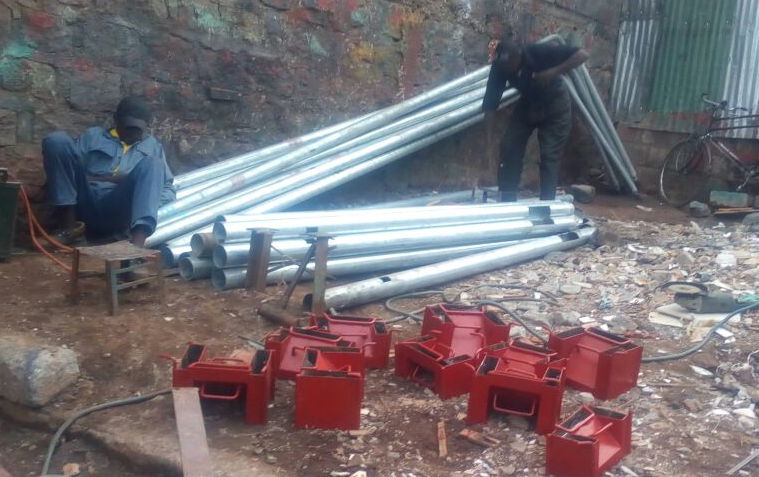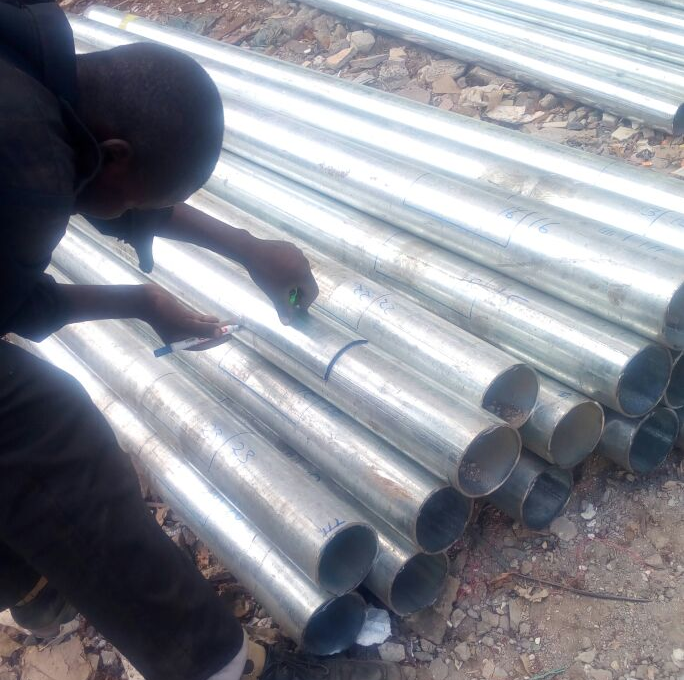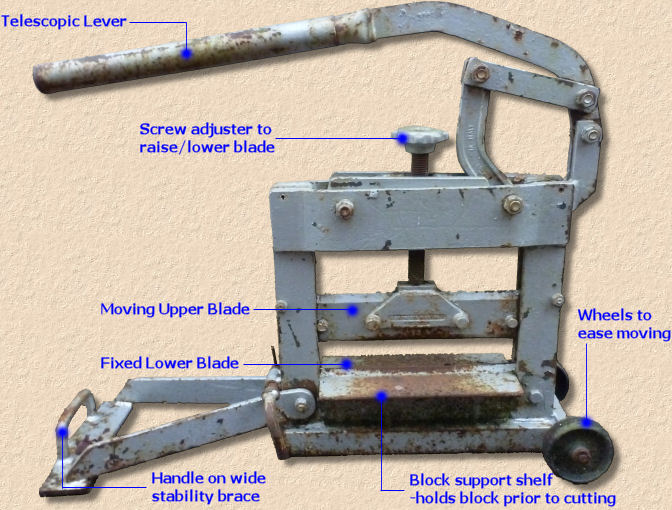 projects have a maximum jaw opening of around 100mm and a jaw length of 300-450mm, while those used to split flags and natural stone tend to be noticeably bigger, and may incorporate a hydraulic jack to maximise the cutting power on thicker, tougher materials work by adjusting the height of the jaw opening via a screw mechanism so that the block (or other elements) to be cut just fits between the upper and lower blades and then using the eccentric cam attached to the lever to force the upper blade downwards, exerting pressure onto the block and causing it to snap in line with the blades
projects have a maximum jaw opening of around 100mm and a jaw length of 300-450mm, while those used to split flags and natural stone tend to be noticeably bigger, and may incorporate a hydraulic jack to maximise the cutting power on thicker, tougher materials work by adjusting the height of the jaw opening via a screw mechanism so that the block (or other elements) to be cut just fits between the upper and lower blades and then using the eccentric cam attached to the lever to force the upper blade downwards, exerting pressure onto the block and causing it to snap in line with the blades
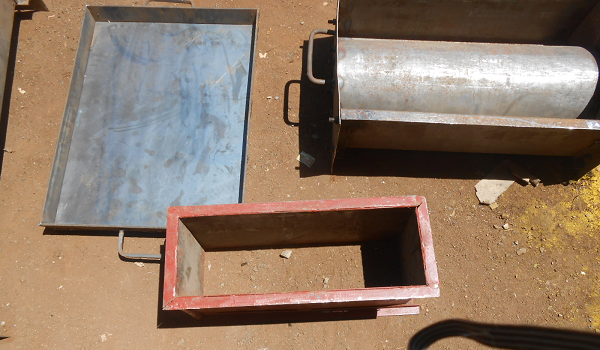 Precast concrete is a construction product produced by casting concrete in a reusable mold or "form" which is then cured in a controlled environment, transported to the construction site and lifted into place. Why choose precast concrete? We could go on for hours, but our favorite attributes are quality, versatility, sustainability, strength, durability and lower lifetime costs. The precast concrete industry offers an almost endless variety of products for above-ground and underground construction. From the largest infrastructure projects to the smallest architectural details, there’s a precast solution for all architects, engineers and construction professionals. kafum precast concrete molds are fabricated using good quality materials to ensure they give molders value for their money. this attribute has endeared many molders to us in considering we offer the best prices on precast concrete molds in Kenya. Some of the molds include Road Kerb, Waffles, Culverts, Fence Post, Road Channel, Paving Slab, Wall Copping, Ball Copping, Stay Block, Hatari Block, Side Slab, Inverted Block Drainage, Hollow Block, Soild Block, Ventilation,Balustrade, Louver Block,
Precast concrete is a construction product produced by casting concrete in a reusable mold or "form" which is then cured in a controlled environment, transported to the construction site and lifted into place. Why choose precast concrete? We could go on for hours, but our favorite attributes are quality, versatility, sustainability, strength, durability and lower lifetime costs. The precast concrete industry offers an almost endless variety of products for above-ground and underground construction. From the largest infrastructure projects to the smallest architectural details, there’s a precast solution for all architects, engineers and construction professionals. kafum precast concrete molds are fabricated using good quality materials to ensure they give molders value for their money. this attribute has endeared many molders to us in considering we offer the best prices on precast concrete molds in Kenya. Some of the molds include Road Kerb, Waffles, Culverts, Fence Post, Road Channel, Paving Slab, Wall Copping, Ball Copping, Stay Block, Hatari Block, Side Slab, Inverted Block Drainage, Hollow Block, Soild Block, Ventilation,Balustrade, Louver Block,
.
 Pre-cast concrete units are now the most popular choice for kerbing. Hydraulically-pressed kerbs are strong, durable, cheap and can be manufactured to strict tolerances (BS EN 1340). There are some special shapes, notably quadrants and some droppers, which are still manufactured from vibrated concrete, although this material isn't as strong as a pressed concrete.
Pre-cast concrete units are now the most popular choice for kerbing. Hydraulically-pressed kerbs are strong, durable, cheap and can be manufactured to strict tolerances (BS EN 1340). There are some special shapes, notably quadrants and some droppers, which are still manufactured from vibrated concrete, although this material isn't as strong as a pressed concrete.
Standard kerbs have a pimpled finish and come in a fetching shade of concrete grey. More decorative (and therefore more expensive) kerbs are becoming popular on prestige and 'Heritage' schemes, with features such as exposed aggregates and textured finishes
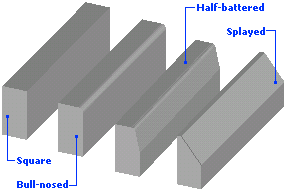 There are 4 basic profiles to the most common, pcc road kerbs used throughout Britain.
There are 4 basic profiles to the most common, pcc road kerbs used throughout Britain.
- Half-battered
- Bull-nosed
- Splayed
- Square
Traditionally, most straight kerbs are 915mm in length (a hangover from the pre-metric days), although some of the kerb-units developed to match block-paving are only 100mm or 200mm long. Radius kerbs, ie those designed to form curves of less than 10m radius, are shorter than the equivalent straight units and the most modern ranges are being manufactured as 780mm in length.
 All kerbs, other than those with a square profile, have what is known as a 'watermark' or a 'waterline'. This is a line on the face above which surfacing (and therefore surface water) is not normally expected to extend. In many cases, the surfacing level is kept 25mm or more below the watermark. The watermark is not a physical mark but generally coincides with a change in angle of the kerb face. watermark
All kerbs, other than those with a square profile, have what is known as a 'watermark' or a 'waterline'. This is a line on the face above which surfacing (and therefore surface water) is not normally expected to extend. In many cases, the surfacing level is kept 25mm or more below the watermark. The watermark is not a physical mark but generally coincides with a change in angle of the kerb face. watermark
 The most commonly used pcc road kerbs are the half-battered profile. These provide an element of check sufficient to warn motorists that they are dangerously close to the edge of the carriageway, while the 'sloping back' profile enables road rollers to operate right up to the edge of the pavement without scratching or damaging the kerb face when the surfacing is laid. They are normally used where a footpath is provided adjacent to the carriageway
The most commonly used pcc road kerbs are the half-battered profile. These provide an element of check sufficient to warn motorists that they are dangerously close to the edge of the carriageway, while the 'sloping back' profile enables road rollers to operate right up to the edge of the pavement without scratching or damaging the kerb face when the surfacing is laid. They are normally used where a footpath is provided adjacent to the carriageway
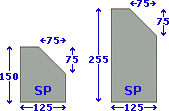
Splayed profile kerbs are used in those situations where a vehicle may need to 'bump up' onto a verge in an emergency. For safety reasons, these are not used when a footpath is present.
 Where a crossing is required, normally for access to a private driveway, access point or pedestrian crossing, a bull-nosed or chamfered kerb is used. While the bull-nose kerb shown opposite is a British Standard kerb, the chamfered unit (in violet) is NOT and can only be obtained via certain manufacturers. The consent of the Local Authority Highways Department is required to use non-BS kerbs on public highways.
Where a crossing is required, normally for access to a private driveway, access point or pedestrian crossing, a bull-nosed or chamfered kerb is used. While the bull-nose kerb shown opposite is a British Standard kerb, the chamfered unit (in violet) is NOT and can only be obtained via certain manufacturers. The consent of the Local Authority Highways Department is required to use non-BS kerbs on public highways.
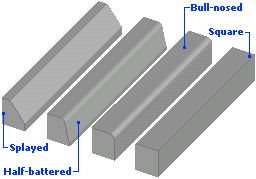 The pcc kerbs illustrated on this page are manufactured to prescribed sizes. The larger kerbs are approx. 125x255mm or 155x305mm, while the smaller units, are approx 125x155mm or 150x150mm. These smaller kerbs are typically used as 'crossing kerbs', on housing estate cul-de-sacs where no footpath is present, or in situations where a full-depth kerb would not be feasible, such as on a bridge deck. Transition kerbs, or 'droppers' as they are sometimes called, are used to link two differing kerb profiles. These are most commonly seen on 'dropped crossings', as illustrated
The pcc kerbs illustrated on this page are manufactured to prescribed sizes. The larger kerbs are approx. 125x255mm or 155x305mm, while the smaller units, are approx 125x155mm or 150x150mm. These smaller kerbs are typically used as 'crossing kerbs', on housing estate cul-de-sacs where no footpath is present, or in situations where a full-depth kerb would not be feasible, such as on a bridge deck. Transition kerbs, or 'droppers' as they are sometimes called, are used to link two differing kerb profiles. These are most commonly seen on 'dropped crossings', as illustrated
Lightweight pcc kerbs
erbs have always been heavy, cumbersome things and they take their toll on installers (as I can testify!), and so there has been a move within the industry, spurred on by health and safety concerns, to look at various options for reducing the wear and tear on kerb-layers.
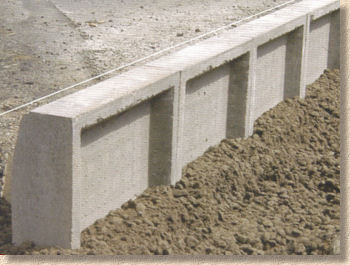 Along with machine-aided installation, one of the options considered is a lighter kerb, and the K-Lite manufactured by Kafum is a prime example. The kerb length has been reduced to a much more manageable 450mm, but the form of the kerb has also been altered, creating a frog (a recess) in the rear of the kerb unit, which dramatically reduces weight to just 20kg per unit. The frog is eventually filled with haunch concrete and there is no loss of performance from the completed kerbline - just fewer knackered kerb-layers!
Along with machine-aided installation, one of the options considered is a lighter kerb, and the K-Lite manufactured by Kafum is a prime example. The kerb length has been reduced to a much more manageable 450mm, but the form of the kerb has also been altered, creating a frog (a recess) in the rear of the kerb unit, which dramatically reduces weight to just 20kg per unit. The frog is eventually filled with haunch concrete and there is no loss of performance from the completed kerbline - just fewer knackered kerb-layers!
Special Kerbs
Other kerbs seen on the highways of the nations include....

Side Offlet Kerbs, sometimes known as Weir Kerbs, for use with behind-kerb drainage systems. They have largely been replaced by kerb-drain units nowadays, but they were quite popular 25+ years ago. They often have a cast iron or steel grille or facing to keep the worst of the street litter out of the sewers.
High Containment Kerb
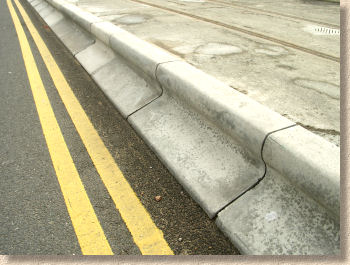 High Containment Kerb, such as the Trief or Titan kerbs. These are used to prevent traffic leaving the carriageway and are often used to protect vulnerable footpaths or sensitive roadside equipment, such as fuel pumps at filling stations, pedestrian islands, dangerous curves, etc. These are BIG kerbs, measuring around 450mm in height and weighing almost a quarter of a tonne
High Containment Kerb, such as the Trief or Titan kerbs. These are used to prevent traffic leaving the carriageway and are often used to protect vulnerable footpaths or sensitive roadside equipment, such as fuel pumps at filling stations, pedestrian islands, dangerous curves, etc. These are BIG kerbs, measuring around 450mm in height and weighing almost a quarter of a tonne
Channels
Channel kerbs were once a common sight at the edge of many roads, especially on carriageways where stone kerbs were used. They provided a 'gutter' for the drainage of surface water and provided a spacer between the edge of the macadam or asphalt and the face of the kerb. As pcc kerbs gradually replaced stone kerbs, pcc channels were often used in conjunction with them, but nowadays, they are rarely specified, unless they are used to create 'summits and valleys' adjacent to a relatively flat kerb line.
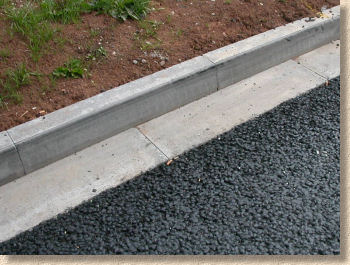

Quadrants and Angles
 As well as the straight and radius kerbs, the manufacturers also supply units with complementary profiles specifically to form right-angles.
As well as the straight and radius kerbs, the manufacturers also supply units with complementary profiles specifically to form right-angles.
The drawing opposite illustrates the Internal and External angle units, and the Quadrant Block, sometimes known as a 'cheese'. The Quadrant Block can be cut with a power saw (and a lot of patience) to create angles of less than 90°
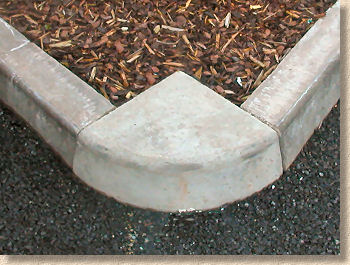

.
 Pre-cast concrete units are now the most popular choice for kerbing. Hydraulically-pressed kerbs are strong, durable, cheap and can be manufactured to strict tolerances (BS EN 1340). There are some special shapes, notably quadrants and some droppers, which are still manufactured from vibrated concrete, although this material isn't as strong as a pressed concrete.
Pre-cast concrete units are now the most popular choice for kerbing. Hydraulically-pressed kerbs are strong, durable, cheap and can be manufactured to strict tolerances (BS EN 1340). There are some special shapes, notably quadrants and some droppers, which are still manufactured from vibrated concrete, although this material isn't as strong as a pressed concrete.
Standard kerbs have a pimpled finish and come in a fetching shade of concrete grey. More decorative (and therefore more expensive) kerbs are becoming popular on prestige and 'Heritage' schemes, with features such as exposed aggregates and textured finishes
 There are 4 basic profiles to the most common, pcc road kerbs used throughout Britain.
There are 4 basic profiles to the most common, pcc road kerbs used throughout Britain.
- Half-battered
- Bull-nosed
- Splayed
- Square
Traditionally, most straight kerbs are 915mm in length (a hangover from the pre-metric days), although some of the kerb-units developed to match block-paving are only 100mm or 200mm long. Radius kerbs, ie those designed to form curves of less than 10m radius, are shorter than the equivalent straight units and the most modern ranges are being manufactured as 780mm in length.
 All kerbs, other than those with a square profile, have what is known as a 'watermark' or a 'waterline'. This is a line on the face above which surfacing (and therefore surface water) is not normally expected to extend. In many cases, the surfacing level is kept 25mm or more below the watermark. The watermark is not a physical mark but generally coincides with a change in angle of the kerb face. watermark
All kerbs, other than those with a square profile, have what is known as a 'watermark' or a 'waterline'. This is a line on the face above which surfacing (and therefore surface water) is not normally expected to extend. In many cases, the surfacing level is kept 25mm or more below the watermark. The watermark is not a physical mark but generally coincides with a change in angle of the kerb face. watermark
 The most commonly used pcc road kerbs are the half-battered profile. These provide an element of check sufficient to warn motorists that they are dangerously close to the edge of the carriageway, while the 'sloping back' profile enables road rollers to operate right up to the edge of the pavement without scratching or damaging the kerb face when the surfacing is laid. They are normally used where a footpath is provided adjacent to the carriageway
The most commonly used pcc road kerbs are the half-battered profile. These provide an element of check sufficient to warn motorists that they are dangerously close to the edge of the carriageway, while the 'sloping back' profile enables road rollers to operate right up to the edge of the pavement without scratching or damaging the kerb face when the surfacing is laid. They are normally used where a footpath is provided adjacent to the carriageway

Splayed profile kerbs are used in those situations where a vehicle may need to 'bump up' onto a verge in an emergency. For safety reasons, these are not used when a footpath is present.
 Where a crossing is required, normally for access to a private driveway, access point or pedestrian crossing, a bull-nosed or chamfered kerb is used. While the bull-nose kerb shown opposite is a British Standard kerb, the chamfered unit (in violet) is NOT and can only be obtained via certain manufacturers. The consent of the Local Authority Highways Department is required to use non-BS kerbs on public highways.
Where a crossing is required, normally for access to a private driveway, access point or pedestrian crossing, a bull-nosed or chamfered kerb is used. While the bull-nose kerb shown opposite is a British Standard kerb, the chamfered unit (in violet) is NOT and can only be obtained via certain manufacturers. The consent of the Local Authority Highways Department is required to use non-BS kerbs on public highways.
 The pcc kerbs illustrated on this page are manufactured to prescribed sizes. The larger kerbs are approx. 125x255mm or 155x305mm, while the smaller units, are approx 125x155mm or 150x150mm. These smaller kerbs are typically used as 'crossing kerbs', on housing estate cul-de-sacs where no footpath is present, or in situations where a full-depth kerb would not be feasible, such as on a bridge deck. Transition kerbs, or 'droppers' as they are sometimes called, are used to link two differing kerb profiles. These are most commonly seen on 'dropped crossings', as illustrated
The pcc kerbs illustrated on this page are manufactured to prescribed sizes. The larger kerbs are approx. 125x255mm or 155x305mm, while the smaller units, are approx 125x155mm or 150x150mm. These smaller kerbs are typically used as 'crossing kerbs', on housing estate cul-de-sacs where no footpath is present, or in situations where a full-depth kerb would not be feasible, such as on a bridge deck. Transition kerbs, or 'droppers' as they are sometimes called, are used to link two differing kerb profiles. These are most commonly seen on 'dropped crossings', as illustrated
Lightweight pcc kerbs
erbs have always been heavy, cumbersome things and they take their toll on installers (as I can testify!), and so there has been a move within the industry, spurred on by health and safety concerns, to look at various options for reducing the wear and tear on kerb-layers.
 Along with machine-aided installation, one of the options considered is a lighter kerb, and the K-Lite manufactured by Kafum is a prime example. The kerb length has been reduced to a much more manageable 450mm, but the form of the kerb has also been altered, creating a frog (a recess) in the rear of the kerb unit, which dramatically reduces weight to just 20kg per unit. The frog is eventually filled with haunch concrete and there is no loss of performance from the completed kerbline - just fewer knackered kerb-layers!
Along with machine-aided installation, one of the options considered is a lighter kerb, and the K-Lite manufactured by Kafum is a prime example. The kerb length has been reduced to a much more manageable 450mm, but the form of the kerb has also been altered, creating a frog (a recess) in the rear of the kerb unit, which dramatically reduces weight to just 20kg per unit. The frog is eventually filled with haunch concrete and there is no loss of performance from the completed kerbline - just fewer knackered kerb-layers!
Special Kerbs
Other kerbs seen on the highways of the nations include....

Side Offlet Kerbs, sometimes known as Weir Kerbs, for use with behind-kerb drainage systems. They have largely been replaced by kerb-drain units nowadays, but they were quite popular 25+ years ago. They often have a cast iron or steel grille or facing to keep the worst of the street litter out of the sewers.
High Containment Kerb
 High Containment Kerb, such as the Trief or Titan kerbs. These are used to prevent traffic leaving the carriageway and are often used to protect vulnerable footpaths or sensitive roadside equipment, such as fuel pumps at filling stations, pedestrian islands, dangerous curves, etc. These are BIG kerbs, measuring around 450mm in height and weighing almost a quarter of a tonne
High Containment Kerb, such as the Trief or Titan kerbs. These are used to prevent traffic leaving the carriageway and are often used to protect vulnerable footpaths or sensitive roadside equipment, such as fuel pumps at filling stations, pedestrian islands, dangerous curves, etc. These are BIG kerbs, measuring around 450mm in height and weighing almost a quarter of a tonne
Channels
Channel kerbs were once a common sight at the edge of many roads, especially on carriageways where stone kerbs were used. They provided a 'gutter' for the drainage of surface water and provided a spacer between the edge of the macadam or asphalt and the face of the kerb. As pcc kerbs gradually replaced stone kerbs, pcc channels were often used in conjunction with them, but nowadays, they are rarely specified, unless they are used to create 'summits and valleys' adjacent to a relatively flat kerb line.


Quadrants and Angles
 As well as the straight and radius kerbs, the manufacturers also supply units with complementary profiles specifically to form right-angles.
As well as the straight and radius kerbs, the manufacturers also supply units with complementary profiles specifically to form right-angles.
The drawing opposite illustrates the Internal and External angle units, and the Quadrant Block, sometimes known as a 'cheese'. The Quadrant Block can be cut with a power saw (and a lot of patience) to create angles of less than 90°


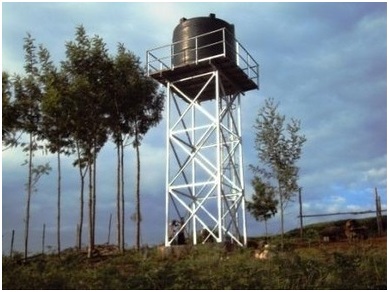 For a water tower (elevated storage tank) , above-ground tank, our in-house engineering and construction teams have the experience to design and build your customized water tank platform, covering all tank styles and capacities. Join thousands of satisfied customers and let kafum, with safety and quality as core values, help solve your water storage needs on time and within budget. Over the years Kafum has committed its resources to providing engineered structures and exemplary service for domestic, municipal water storage and industrial storage facilities. Today, our diverse experience makes us uniquely qualified in many instances to deliver the value-added, engineered solutions you demand. One thing you can be sure of is that when it comes to water tower construction, kafum engineering don't compromise on safety. this has endeared us to most county governments in Kenya, green house farmers schools, hospitals, university's and residential s who have entrusted us to construct high quality, safe water towers across Kenya.
For a water tower (elevated storage tank) , above-ground tank, our in-house engineering and construction teams have the experience to design and build your customized water tank platform, covering all tank styles and capacities. Join thousands of satisfied customers and let kafum, with safety and quality as core values, help solve your water storage needs on time and within budget. Over the years Kafum has committed its resources to providing engineered structures and exemplary service for domestic, municipal water storage and industrial storage facilities. Today, our diverse experience makes us uniquely qualified in many instances to deliver the value-added, engineered solutions you demand. One thing you can be sure of is that when it comes to water tower construction, kafum engineering don't compromise on safety. this has endeared us to most county governments in Kenya, green house farmers schools, hospitals, university's and residential s who have entrusted us to construct high quality, safe water towers across Kenya.
Streets lighting company's and county governments across Kenya can testify that when it comes to street lighting poles fabrication in Kenya no other street light manufacturer come close to kafum engineering.
The flexibility of our manufacturing process provides consistency from small to large street lighting poles and structures. This allows for a customized pole design made to your exact specifications with the right materials to withstand the harshest environments.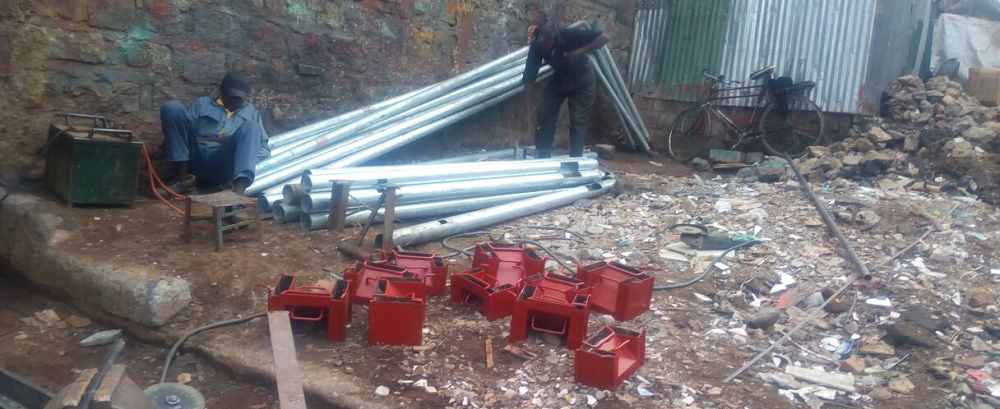
From our unique stainless steel light poles to our cost-effective Kafum paint process, you will benefit from reduced maintenance expenses and a longer service lives with kafum lighting poles and traffic signal structures.
Whether it be an industry standard or an unconventional design; our sales staff, in-house engineers and experienced craftsmen are ready to assist you in finding the perfect lighting structure to fit both your project and budget. looking for where to buy street lights poles in kenya?. welcome to kafum
